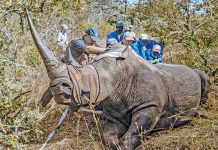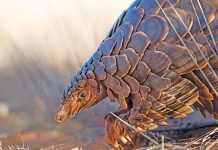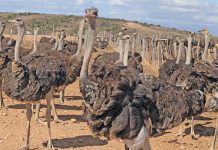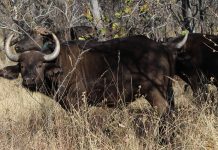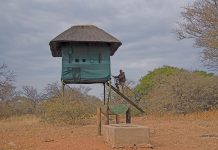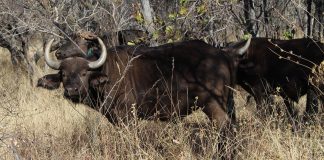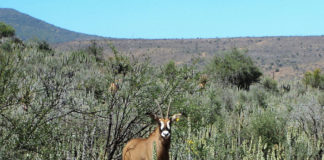A bakkie bristling with birdwatchers and camera lenses cruising around the 2 500ha sheep farm, traditionally known as Cyferfontein, is a common sight these days.
“We get an unbelievable number of people coming here to watch birds,” says Riëtte Griesel, showing the available accommodation on Garingboom Guest Farm near Springfontein in the southern Free State. Guests come from as far afield as Europe, North America, Asia and Australia to see the rare new pipit species.
“I take the visitors out in the bakkie, and everyone has a bigger camera than the next,” says Riëtte. As for identifying the new species of pipits, all credit should go to Dr Richard Liversidge, the late director of Kimberley’s McGregor Museum. In the 1990s he often took his dogs for walks on open land in Kimberley, where pipits flitted about.
Here he observed two pipits he had never seen before. Intrigued, he began studying specimens from across central South Africa, mostly housed in museums such as the National Museum (NM) in Bloemfontein.
The “difficult pipit”
Dr Liversidge’s efforts were rewarded when DNA tests conducted in the US confirmed that the long-tailed pipit was a new species. But there was more – a specimen the NM used in the DNA tests turned out to be another new species – the other pipit Dr Liversidge had seen in Kimberley.
He learnt the specimen had been collected by the NM from Garingboom, where Riëtte was struggling to identify a particular pipit while compiling a list of birds for the farm. Dr Liversidge immediately contacted her.
“He asked if I’d seen any pipit on the farm that I couldn’t identify. I told him there was one I wasn’t sure about. I knew it wasn’t the long-billed pipit as it didn’t have the correct song and it looked different,” recalls Riëtte. And so Dr Liversidge visited Garingboom.
The new species was first called the “difficult pipit” since Dr Liversidge and Riëtte struggled to find it and distinguish it physically and behaviourally from other pipits.
Continuing their quest in Kimberley and Springfontein, they learnt the difficult pipit was prone to run for long distances, preferred to feed in sparse, open areas, and exhibited a deep downward wag of its tail.
Identifying the pipit
Perseverance brought in more data. “The pipit we discovered has beautiful stripes, especially on the head,” explains Riëtte. “The yellow colour, white eye stripe, yellow at the base of the lower mandible, long tail and orange legs are characteristics that distinguish it from other species.”
The team was also determined to record the call of the difficult pipit, specifically during breeding season, a critical identification tool between species.
“During breeding, three notes of the bird’s call during display flight are at a different pitch to each other. The bird flies at a steep angle of 20m to 30m and descends in a series of steps and in a circle while calling,” says Riëtte. Because the difficult pipit was seen on Garingboom during summer, it was assumed the bird bred in the area.
The next challenge was to find a nest. After years of searching, Riëtte finally came across one in thick grass on the edge of a grazed opening on Garingboom. They were on the verge of a major find.
Not long after the Garingboom flood, Dr Liversidge spotted difficult pipits between Fouresmith and Jagersfontein. “There we found a nest with eggs and another nest with chicks that we ringed – so somewhere in the world there is a Kimberley pipit with a ring on it,” she says with a chuckle.
Soon more nests were found on Garingboom, and by 2000, the intricate process of DNA sampling backed up by years of fieldwork made it possible to have the difficult pipit recognised as a new species – the Kimberley pipit.
Making headway but losing a friend
In 2003, Dr Liversidge passed away. It was just as Riëtte began to make headway with further research on the long-tailed pipit after a specimen was collected by the NM from Garingboom on 13 November. She knew that finding the Long-tailed pipit in summer implied these pipits were probably year-round residents in the Springfontein area.
However, to prove they were breeding in the area, Riëtte had to find a nest. It’s a difficult task as this particular pipit is incredibly hard to identify. “It looks just like a Buffy pipit (Anthus vaalensis), except for the colour of the bottom of the bill.”
She’s made some headway and has identified specific habitats the Long-tailed pipit seems to prefer, but admits she misses the expertise and companionship of Dr Liversidge.
“Habitat identification is important to me. I’ve learnt Long-tailed pipits prefer open veld rather than the rantjies,” says Riëtte. “There is so much work that still needs to be done and I miss Dr Liversidge. I could always phone him if I had a question.”
Contact Riëtte Griesel on 051 783 0203 or 082 900 9888.

